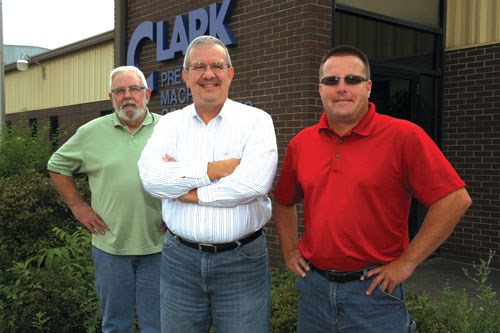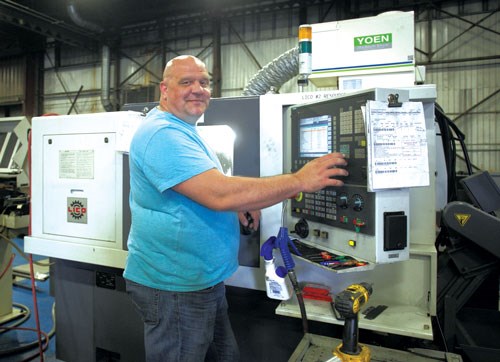Multi-Spindle to Multitasking: A Journey in Productivity
After switching from its outdated multi-spindle machines to multitasking turn-mill centers, this company immediately began reaping the rewards of productivity and throughput increases as well as cost reductions.
When faced with the difficult challenges of finding skilled labor for multi-spindle machines and the dwindling lot sizes that are cutting into the profitability of jobs, changes must be made to overcome these obstacles.
The management at Clark Precision Machined Components, in Blawnox (Pittsburgh), Pennsylvania, was forced to make some decisions that improved the shop’s dynamics. After switching from its outdated multi-spindle machines to multitasking turn-mill centers, the company immediately began reaping the rewards of productivity and throughput increases as well as cost reductions.
Started in 1949 as a family-owned, multi-spindle shop, Clark still focuses primarily on multi-spindle machines. It runs 29 multi-spindle machines (mostly Acmes, a few New Britains), two CNC mills that perform secondary operations for its multis, three CNC lathes, and its latest addition—three CNC screw machines. The company also has a cold-drawn bar division that produces bars from 5/8 inch to 3.5 inches for its own use (10 percent of its business) and for the commercial market (90 percent).
Once the screw machine job shop realized its outdated multi-spindle machines were not efficient enough to keep up with productivity, its management team went to work researching options. Team members knew they needed to either replace or repair several of the older Acme multi-spindles.
Research included CNC Swiss machines, which were eventually eliminated because of Clark’s target production requirements. With its expertise in multi-spindle work, CNC multis were a natural choice. However, between the expense and small lot sizes, those were eliminated. And adding more CNC lathes did not satisfy the company’s needed cycle times.
The team finally reviewed the capabilities and pricing of the Lico line of CNC turn-mill centers and was convinced this machine fit the requirements.
The company purchased a model LNT 42S-S4-T2, which comes standard with three cross slides (two axis), a live tool eight-station turret with a pickoff spindle, a four-tool backworking platform, dual high pressure pumps (1,000 psi each) and a parts conveyor. It opted for a fourth cross slide, an eight-tool backworking turret, a chip conveyor and an oil mist collector. To handle the four cross slides, the machine comes with a Siemens 840 D controller.
With this new machine, the company is not only able to offload shorter run production from its multi-spindles, the Lico machines were able to finish complete some automotive jobs, eliminating two secondary operations from the multis. Since the company was able to finish some emergency work for a customer and started making on-time deliveries that were becoming a problem for the multis, management purchased another Lico on the used market, then another at PMTS 2015 (Precision Machining Technology Show), giving the company three Lico machines—one 42 mm and two 65 mm.
Since implementing these machines, Clark has seen part costs drop. For example, a steel part (1018) 1.5 inches in diameter (basically a bushing with OD steps) was calculated on the multis at only a few parts per hour higher than the Lico machines. The lot size was 8,000 pieces, with the setup time costing $0.08 per piece on the multis compared with $0.015 per piece on the single-spindle machine. Plus, the parts that were machined on the multi had to go through a deburring process not necessary on the Lico, which added $0.028 to the part cost. With the part production per hour difference being negligible, the cost per part was $0.093 higher on the multi-spindle than on the Lico machine.
Looking for similar savings, the company found a 316 stainless job with a lot size of 6,250 pieces that it had not run before. The part required a surface finish that would have been challenging for form tools, even under the best conditions. The multi-spindle production had a 15-pph advantage over the Lico. However, the difference in setup costs ($0.12 per part), secondary operation ($0.06 per part), and risk on the surface finish gave the process on the multitasking machine an advantage.
The Clark team has since transferred more jobs to its multitasking machines. These would previously have required multiple secondary operations after its multi-spindle operations. “The initial process would be faster on the multis,” says Tom Johnson, manufacturing engineer manager. “But when you add up the costs of multiple secondary operations, plus the benefit of shorter runs, the Lico machines win.”
Although the new machines have many benefits, they came with challenges as well. Advanced Machinery Solutions (AMS), the North American importer for Lico, provided training for Clark’s programmer. Toby Stobart, AMS’ application engineer, helped the young programmer at Clark adapt to the machines. However, soon thereafter, the programmer left the company for another job. As a result, Clark hired an experienced programmer for CNC lathes, but he did not have Siemens controller experience. Also, all his experience was on single- or twin-spindle lathes, with little overlapping tool experience. The Lico machine can operate with all the slides cutting simultaneously.
Most often, there are two to four tools in the cut at one time. This is a significant paradigm shift for a single-spindle lathe programmer. Screw machine operators are used to overlapping slides, but they are foreign to single-spindle CNC lathe programmers.
Today, Clark’s new programmer, Ken Czarnicki, is becoming adept to programming the overlapping slides. Changing control systems and adopting the new paradigm of parallel versus serial processing was a lot to bite off, but it is offset by the many opportunities to reduce cycle times. The first thing he does now is look for overlapping processes to save cycle time.
Recently, Mr. Czarnicki wanted to mill two wrench flats on a part. AMS advised him to polygon mill the part instead. He had it programmed and had run an initial sample in less than 2 hours. “This was so much easier than milling the flats on the parts,” he says. “Our machines do not have the Y-axis option, so I would have needed to use a C- and X-axis interpolation to mill these flats. With the polygon turning, I programmed the turn, timing the spindle speeds together, and turned the flats on the part.”
“Overall, we are pleased with our ability to increase our product portfolio with the Lico machines,” says Tony Kurley, president and CEO. “We can hold tighter tolerances, achieve better finishes, eliminate secondary work and produce in lower lot sizes, compared with our multi-spindle machines. This results in improved productivity, increased throughput and reduced costs.”
Additionally, Mr. Kurley believes the company has found an excellent and responsive business partner in AMS—one he can rely on for providing the customer support that Clark demands.
For more information from Clark Precision Machined Components, call 412-828-1210, or visit clarkprecision.com.
Related Content
The Control’s Role in Machining Complex Parts
This company that produces medical implants finds value in the CNC for its turn-mill equipment that helps speed setups and simplify programming when producing intricate parts complete.
Read MorePrecision Machining Technology Review: September 2024
Production Machining’s September 2024 technology showcase includes some of the latest technology from Expand Machinery, Paperless Parts, Monaghan Tooling Group, Walter USA and more.
Read MoreVideo Tech Brief: Twin-Turret, Twin-Spindle Lathe Machining
This machine model features roller linear ways to accommodate low-frequency vibration technology to minimize chip size.
Read MoreChoosing the Right Machine for Turned and Milled Medical Parts
The medical market is known for exceptionally tight tolerances and difficult materials, which means that selecting the proper machine is necessary to ensure a job is profitable.
Read MoreRead Next
Emerging Leaders Nominations Now Open
Here’s your chance to highlight a young person in your manufacturing business who is on the path to be a future leader moving your company forward.
Read More5 Aspects of PMTS I Appreciate
The three-day edition of the 2025 Precision Machining Technology Show kicks off at the start of April. I’ll be there, and here are some reasons why.
Read MoreDo You Have Single Points of Failure?
Plans need to be in place before a catastrophic event occurs.
Read More











.jpg;maxWidth=300;quality=90)


.jpg;maxWidth=300;quality=90)












